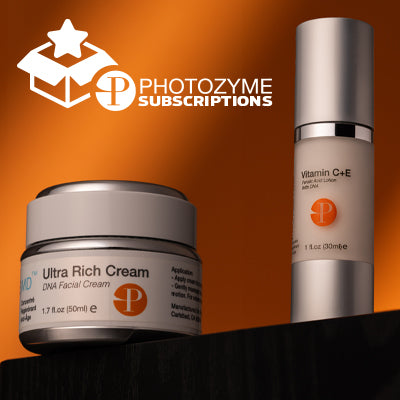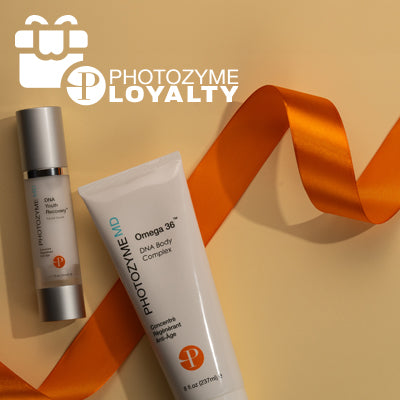
Understand the science behind adapalene vs retinol. Learn which is right for your skin and enhance your regimen with Photozyme’s advanced solutions.
Key Takeaways:
- Mechanism Matters: Adapalene and retinol are vitamin A derivatives for anti-aging and acne treatment, but their mechanisms and efficacy profiles differ.
- Choosing Based On Skin Goals: Adapalene and retinol depend on individual skin needs, sensitivity, and goals. Adapalene offers more targeted action for acne, while retinol is a gentler option for anti-aging.
- Application Strategy: Successfully incorporating adapalene or retinol into a skincare routine requires careful consideration of formulations, concentration, skin type, and professional consultation to achieve optimal results and minimize side effects.
Adapalene and retinol deliver results when refining skin texture, reducing breakouts, and minimizing signs of aging, but not in the same way. One targets acne precisely, while the other offers a gentler path to radiance. Choosing the right one depends on your skin's needs, sensitivities, and long-term goals. Knowing each ingredient's clinical strengths and limitations can make all the difference in building a smarter regimen.
At Photozyme, we drive clinical innovation. Every formula we create is built on patented DNA repair enzyme technology proven to correct photodamage at the source. Dermatologist-trusted and results-focused, our products are designed to support fundamental transformation, not surface-level fixes. For skin that demands science-backed performance and long-term rejuvenation, we’re the brand that professionals and patients choose to deliver consistent, visible, and biologically meaningful results.
In this article, we’ll examine critical differences between adapalene and retinol, including their mechanisms of action, ideal use cases, skin tolerability, and how to integrate each into a science-backed skincare routine for optimal, long-term results.
How Do Adapalene And Retinol Benefit The Skin?
Both adapalene and retinol are central players in advanced skin rejuvenation for good reason – they harness the power of retinoids, one of the most rigorously studied classes of topical agents. But how do they work, and what tangible benefits do they provide for skin health?
Adapalene: The Precision Retinoid
Adapalene is a third-generation synthetic retinoid, developed to provide targeted action with improved tolerability compared to older retinoids. Mechanistically, adapalene binds selectively to specific retinoic acid receptors in the skin, modulating cellular differentiation and inflammation.
This translates to multiple clinical benefits:
- Prevention & Reduction Of Acne: Adapalene minimizes the formation of comedones and inflammatory lesions by normalizing skin cell turnover and reducing the clogging of pores.
- Diminished Hyperpigmentation: Regular use can lead to a more even tone by dispersing existing pigment and inhibiting new pigment formation.
- Refined Skin Texture: Enhanced exfoliation and promotion of new cell growth result in smoother, more uniform skin.
- Collagen Support: While adapalene is less potent than tretinoin in stimulating collagen, long-term use improves firmness and subtle softening of fine lines.
Retinol: The Gold Standard For Age Defense
Retinol, a pure form of Vitamin A, is one of the most widely used non-prescription retinoids. Once absorbed by the skin, it’s converted into retinoic acid, the active form that impacts cellular function.
Its benefits include:
- Visible Reduction Of Fine Lines & Wrinkles: Retinol stimulates collagen synthesis, thickening the dermis and reducing the appearance of aging signs. Using a professional-grade retinol cream for the face can further enhance these anti-aging benefits with targeted delivery systems.
- Smoother, More Luminous Skin: Gentle resurfacing encourages the fading of rough patches, mild discoloration, and photodamage.
- Minimized Pore Appearance: Retinol helps keep pores unclogged and less noticeable by enhancing epidermal turnover.
- Blemish Control: Though less focused on acne than adapalene, retinol can help reduce breakouts, particularly for those managing acne and aging signs. Pairing these retinoids with our DNA repair serum can also amplify long-term correction and support skin recovery on a cellular level.
Which Skin Types Benefit From Adapalene And Retinol Respectively?
Understanding which molecule best suits your skin type is critical when weighing adapalene vs. retinol. Despite their shared reputation as powerhouse vitamin A derivatives, adapalene and retinol serve distinct needs, tolerances, and skin conditions.
Why Adapalene Works Best For Acne-Prone Skin
This synthetic retinoid is most frequently recommended for oily and acne-prone skin. Its stable molecular structure is less irritating than prescription retinoids, making it suitable for individuals with moderate to severe acne or those susceptible to frequent breakouts and visible pores. Adapalene’s comedolytic (pore-clearing) actions also make it a reliable candidate for resilient skin types or anyone seeking targeted treatment for congestion, blackheads, and inflammatory acne. Learning whether retinol does help with acne is critical because, while adapalene is often the go-to for acne, retinol also plays a role by accelerating cell turnover and helping prevent clogged pores, particularly in milder cases.
Tolerability And Initial Reactions With Adapalene
Sensitive skin types may still experience dryness, redness, and flaking – especially during the first weeks of therapy – but adapalene is specifically designed to minimize irritation compared to other retinoids, particularly tretinoin. Oily complexions tend to handle adapalene’s potency more comfortably, especially when introduced in a controlled, gradual fashion.
Retinol As A Gentle Option For Dry And Aging Skin
In contrast, retinol is gentler and more versatile, making it preferred for drier, mature, or more sensitive skin. Because over-the-counter retinol products must first undergo conversion within the skin to become biologically active, their effects are delivered more slowly, resulting in less upfront irritation. Best retinol for sensitive skin formulas often include encapsulated delivery systems and calming ingredients like niacinamide to reduce the risk of irritation while offering visible results. Retinol anti-aging cream options are a mainstay in routines focused on smoothing fine lines, improving skin tone, and restoring firmness.
Making The Right Choice For Your Skin Profile
Ultimately, choosing between adapalene vs. retinol should involve carefully evaluating your skin concerns and sensitivities, often in consultation with a professional. Matching the unique strengths of each molecule to your skin profile can help you unlock the maximum rejuvenating benefits with minimum risk of irritation.
How To Incorporate Adapalene And Retinol Into Your Skincare Routine
Adding adapalene and retinol to your regimen requires both strategy and patience. Both are powerful, science-backed tools for addressing aging, photodamage, and textural irregularities, but they have essential differences in potency and tolerability that will influence how you should approach them.
Start Slowly And Patch Test
No matter which ingredient you begin with, start slow. Apply a pea-sized amount to clean, dry skin two to three times a week at night, gradually increasing frequency as your skin acclimates. A patch test behind the ear or along the jawline for several nights can help you detect any early signs of irritation or sensitivity. How often to use retinol depends on your skin’s tolerance – start with two to three nights per week and build up gradually for best results.
Choose The Right Step In Your Routine
Adapalene and retinol work best after cleansing and thoroughly drying your face. Oils, creams, or other serums should be layered after your active ingredient to lock in moisture and reduce potential irritation. Never combine them in the same routine; alternate nights or choose one, depending on your skin’s tolerance and goals. Retinol or moisturizer first? Apply retinol first, allow it to absorb fully, then use a moisturizer to buffer and support the skin barrier.
Hydration And Barrier Support Are Critical
These actives can disrupt your skin’s barrier, leading to dryness or flaking. Counteract this by pairing them with a gentle, hydrating moisturizer and avoiding harsh cleansers, scrubs, or other potential irritants (like benzoyl peroxide or alpha-hydroxy acids) on the same night. What not to use with retinol includes benzoyl peroxide, strong exfoliants, and vitamin C in the same routine, as these combinations may heighten irritation.
Timing And Sun Protection
Adapalene and retinol should be reserved for nightly use. Sun exposure can deactivate retinoids and sensitize skin, increasing the risk of photodamage. Daily broad-spectrum sunscreen (SPF 30 or higher) is non-negotiable to protect your results and prevent further aging.
Monitor And Adjust
Expect some initial dryness, mild redness, or peeling as your skin adapts – this phenomenon, known as reionization, is temporary for most users. If irritation persists, reduce frequency or consult with a dermatology professional for guidance on optimizing your regimen.
Choosing The Right Concentration And Formulation
When comparing adapalene vs retinol, determining the proper concentration and formulation is crucial for both efficacy and tolerability. Both ingredients are available in a range of strengths and vehicles, from over-the-counter preparations to prescription-grade options, and their impact on your skin can vary significantly depending on how they are delivered.
Adapalene: Strengths And Vehicle Types
Adapalene is most often available in concentrations of 0.1% and 0.3%, commonly in gel or cream vehicles. Gel formulations are typically preferred for oilier, acne-prone skin due to their lighter texture and enhanced penetration. At the same time, creams provide additional hydration, making them suitable for drier or more sensitive skin types. Prescription forms of adapalene may offer increased potency, but should always be introduced with caution and under professional guidance to minimize irritation.
Retinol: Customizable Strength For Gradual Tolerance
Retinol concentrations vary even more widely, typically from 0.25% to 1% in cosmetic formulations. Lower concentrations are ideal for first-time users or sensitive skin, serving as an entry point before progressing to stronger strengths as skin builds tolerance. Retinol is commonly formulated with emollients or encapsulated delivery systems to stabilize the ingredient, enhance absorption, and mitigate potential irritation. How to use retinol effectively starts with applying a small amount at night on clean, dry skin, gradually increasing frequency while pairing it with gentle, hydrating products to support skin resilience.
Matching Formulations To Skin Type And Concerns
When selecting between adapalene and retinol and their individual concentrations, it’s essential to consider the patient’s skin type, current regimens, and specific skin concerns. Sensitive or compromised skin generally benefits from lower concentrations and more nourishing, barrier-supportive vehicles. Those with resilient skin seeking maximum results against photodamage or severe texture irregularities may tolerate or require higher-strength formulations. Moreover, hyaluronic acid and retinol work synergistically – using hyaluronic acid before retinol helps buffer potential dryness and enhances hydration, improving overall tolerance and results.
Supporting Ingredients To Enhance Results
Finally, pairing retinoids with supportive ingredients such as niacinamide, ceramides, or DNA repair enzymes may enhance efficacy and skin comfort. Tailoring the concentration and the formulation to your unique needs maximizes efficacy and long-term skin health, ensuring your anti-aging regimen remains robust and sustainable.
When To Expect Results From Adapalene And Retinol
When integrating a topical retinoid into your skincare regimen, understanding the expected timeline for visible results is crucial for setting proper expectations and encouraging adherence.
- Retinol Results Timeline: Most users start seeing subtle skin texture and radiance improvements within 4 to 6 weeks of consistent retinol use. More visible changes, such as reduced fine lines and improved photodamage, typically appear after 3 to 6 months. Choosing the best retinol cream for wrinkles can accelerate these visible improvements, especially when paired with barrier-supporting ingredients.
- Mechanism Of Retinol: Retinol works by gently accelerating epidermal cell turnover, which supports gradual rejuvenation while maintaining tolerability for most skin types.
- Adapalene Results Timeline: Initial benefits with adapalene, such as reduced acne lesions and improved surface clarity, often appear within 2 to 4 weeks. More profound anti-aging effects become evident over 8 to 12 weeks.
- Mechanism Of Adapalene: Adapalene’s synthetic structure targets specific retinoid receptors, promoting efficient cellular renewal with less irritation than traditional retinoic acid.
- Importance Of Patience & Consistency: Both ingredients require long-term commitment. Consistent application and daily sun protection are key to achieving optimal results without compromising skin health.
- Managing Initial Reactions: Mild dryness, redness, or flaking may occur during adjustment. Supportive products such as moisturizers and gentle cleansers can reduce irritation and help maintain skin comfort.
Final Thoughts
Choosing between adapalene and retinol comes down to understanding your skin’s unique needs, tolerance level, and long-term goals for skin rejuvenation. Both molecules stand at the forefront of evidence-based dermatological care, offering robust results for age defense and skin renewal. Adapalene is best suited for those seeking a potent, prescription-strength effect, especially if you are managing acne alongside early signs of aging or tolerate more potent retinoids. Retinol, on the other hand, is ideal for individuals entering the retinoid journey, desiring a gentler yet effective route to smoother, firmer, and more even-toned skin.
At Photozyme, we recognize that the optimal anti-aging regimen is rarely one-size-fits-all. Our products harness the most advanced science, including proprietary DNA repair enzymes and next-generation antioxidants, to complement the benefits of proven actives like adapalene and retinol. For consistent results without interruption, our retinol subscription makes it effortless to stay on track with your routine, delivering your chosen formula on schedule.
Read also:
- Does Retinol Help With Dark Spots?
- Best Dermatologist-Approved Retinol Products You Need To Try
-
Retinal vs. Retinol: Which One Is Right For Your Skin?
Frequently Asked Questions About Adapalene vs Retinol
What is adapalene?
Adapalene is a third-generation topical retinoid used primarily to treat acne. It is a synthetic compound derived from vitamin A, designed to regulate cellular turnover and minimize the formation of acne lesions. Adapalene’s molecular structure allows for targeted efficacy with a reduced risk of irritation compared to earlier retinoids, making it a mainstay in clinical dermatology.
What is retinol?
Retinol is a potent form of vitamin A widely used in both over-the-counter and professional skincare formulations. When applied to the skin, retinol is converted into retinoic acid – the biologically active form responsible for boosting collagen synthesis, accelerating cell turnover, and improving visible signs of photoaging such as fine lines, hyperpigmentation, and uneven skin texture.
Who should use retinol?
Retinol is suitable for individuals seeking to address a broad spectrum of skin concerns, including early signs of aging, uneven skin tone, rough texture, and mild hyperpigmentation. It is appropriate for most skin types, except those with extremely sensitive or reactive skin conditions. Professional guidance is advised to determine the optimal formulation and concentration for your specific needs.
Can adapalene help with acne?
Yes, adapalene is specifically engineered to target acne at its source – regulating skin cell turnover and reducing inflammation that contributes to clogged pores and breakouts. Its unique structure offers potent comedolytic properties while being less irritating than older retinoids, making it an excellent choice for adolescent and adult acne management.
What are the side effects of adapalene?
Common side effects of adapalene include temporary redness, dryness, scaling, and mild irritation, especially during the initial weeks of use. Most individuals experience a reduction in these effects as the skin acclimates. Severe adverse reactions are rare, but patients with very sensitive skin or certain dermatologic conditions should consult a professional before starting adapalene therapy.
What are the side effects of retinol?
Retinol can cause temporary irritation, dryness, flaking, and mild redness, particularly when introduced to the skin care routine or used in higher concentrations. These effects typically diminish with continued use as skin builds tolerance. Retinol may increase sun sensitivity, so it is essential to use broad-spectrum sunscreen daily alongside retinol application.





